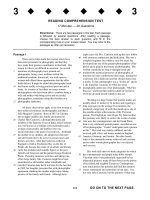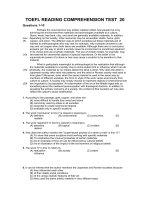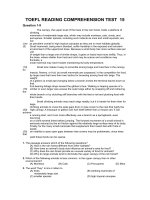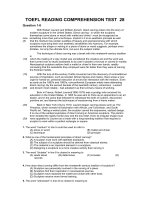TOEFL READING COMPREHENSION TEST 37
Bạn đang xem bản rút gọn của tài liệu. Xem và tải ngay bản đầy đủ của tài liệu tại đây (80.13 KB, 9 trang )
TOEFL READING COMPREHENSION TEST 37
Questions 1-9
It is commonly believed that in the United States that school is where people to
get an
education. Nevertheless, it has been said that today children interrupt their education to
go to school. The distinction between schooling and education implied by this remark
Line is important.
(5) Education is much more open-ended and all-inclusive than schooling. Education
knows no bounds. It can take place anywhere, whether in the shower or on the job,
whether in a kitchen or on a tractor. It includes both the formal leaning that takes place
in school sand the whole universe of informal leaning. The agents of education can
range form a revered grandparent o the people debating politics on the radio, from a
(10) child to a distinguished scientist. Whereas schooling has a certain predictability,
education quite often produces surprises. A chance conversation with stranger may
lead a person to discover how little is known of other religions. People are engaged in
education from infancy on. Education, then, is a very broad, inclusive term. It is a
lifelong process, a process that starts long before the start of school, and one that
(15) should be an integral part of one's entire life.
Schooling, on the other hand, is a specific, formalized process, whose general
pattern varies little from one setting to the next. Throughout a country, children arrive
at school at approximately the same time, take assigned seats, are taught by an adult,
use similar textbooks, do homework, take exams, and so on. The slices of reality that
(20) are to be learned, whether they are the alphabet or an understanding of the workings of
governments, have usually been limited by the boundaries of the subject being taught.
For example, high schools students know that they are not likely to find out in their
classes the truth about political problems in their communities or what the newest
filmmakers are experimenting with. There are definite conditions surrounding the
(25) formalized process of schooling.
1. What is the main idea of the passage?
(A) The best schools teach a wide variety of subjects.
(B) Education and schooling are quite different experiences.
(C) Students benefit from schools, which require long hours and homework.
(D) The more years students go to school the better their education is.
2. What does the author probably mean by using the expression "Children interrupt their
education to go to school" (lines 2-3)?
(A) Going to several different schools is educationally beneficial.
(B) School vacations interrupt the continuity of the school year.
(C) Summer school makes the school year too long.
(D) All of life is an education.
3. The word "bounds" in line 6 is closest in meaning to
(A) rules (B) experiences (C) limits (D)
exceptions
4. The word "chance" in line 11 is closest in meaning to
(A) unplanned (B) unusual (C) lengthy (D) lively
5. The word "integral" in line 15 is closest in meaning to
(A) an equitable (B) a profitable (C) a pleasant (D) an
essential
6. The word "they" in line 20 refers to
(A) slices of reality (B) similar textbooks (C) boundaries (D)
seats
7. The phrase "For example", line 22, introduces a sentence that gives example of
(A) similar textbooks (B) the results of schooling
(C) the working of a government (D) the boundaries of classroom
subject
8. The passage supports which of the following conclusions?
(A) Without formal education, people would remain ignorant.
(B) Education systems need to be radically reformed.
(C) Going to school is only part of how people become educated.
(D) Education involves many years of professional training.
9. The passage is organized by
(A) listing and discussing several educational problems
(B) contrasting the meanings of two related words
(C) narrating a story about excellent teachers
(D) giving examples of different kinds of schools
Questions 10-18
The hard, rigid plates that form the outermost portion of the Earth are about 100
kilometers thick. These plates include both the Earth's crust and the upper mantle.
The rocks of the crust are composed mostly of minerals with light elements, like
Line aluminum and sodium, while the mantle contains some heavier elements, like iron and
(5) magnesium. Together, the crust and upper mantle that form the surface plates are
called
the lithosphere. This rigid layer floats on the denser material of the lower mantle the
way a wooden raft flats on a pond. The plates are supported by a weak, plastic layer
of the lower mantle called the asthenosphere. Also like a raft on a pond, the
lithospheric plates are carried along by slow currents in this more fluid layer beneath
(10) them.
With an understating of plate tectonics, geologists have put together a new
history
for the Earth's surface. About 200 million years ago, the plates at the Earth's surface
formed a "supercontinent" called Pangaea. When this supercontinent started to tear
apart because of plate movement, Pangaea first broke into two large continental
masses
(15) with a newly formed sea that grew between the land areas as the depression filled with
water. The southern one-which included the modern continents of South America,
Africa, Australia, and Antarctic- is called Gondwanaland. The northern one-with
North America, Europe, and Asia-is called Laurasia. North America tore away from
Europe about 180 million years ago, forming the northern Atlantic Ocean.
(20) Some of the lithospheric plates carry ocean floor and others carry land masses or a
combination of the two types. The movement of the lithospheric plates is responsible
for earthquakes, volcanoes, and the Earth's largest mountain ranges. Current
understating of the interaction between different plates explains why these occur
where they do. For example, the edge of the Pacific Ocean has been called the "Ring
(25) of Fire" because so many volcanic eruptions and earthquakes happen there. Before the
1960's, geologist could not explain why active volcanoes and strong earthquakes
were concentrated in that region. The theory of plate tectonics gave them an answer.
10. With which of the following topic is the passage mainly concerned?
(A) The contributions of the theory of plate tectonics to geological knowledge
(B) The mineral composition of the Earth's crust
(C) The location of the Earth's major plates
(D) The methods used by scientists to measure plate movement
11. According to the passage, the lithospheric plates are given support by the
(A) upper mantle (B) ocean floor (C) crust (D)
asthenosphere
12. The author compares the relationship between the lithosphere and the asthenosphere to
which of the following?
(A) Lava flowing from a volcano (B) A boat floating on the water
(C) A fish swimming in a pond (D) The erosion of rocks by running
water
13. The word "one" in line 16 refers to
(A) movements (B) masses (C) sea (D)
depression
14. According to the passage, the northern Atlantic Ocean was formed when
(A) Pangaea was created
(B) Plate movement ceased
(C) Gondwanaland collided with Pangaea
(D) Parts of Laurasia separated from the each other
15. The word "carry" in line 20 could best be replaced by
(A) damage (B) squeeze (C) connect (D)
support
16. In line 27, the word "concentrated" is closest in meaning to which of the following?
(A) allowed (B) clustered (C) exploded (D)
strengthened
17. Which of the following can be inferred about the theory of plate tectonics?
(A) It is no longer of great interest to geologists.
(B) It was first proposed in the 1960's.
(C) It fails to explain why earthquakes occur.
(D) It refutes the theory of the existence of a supercontinent.
18. The paragraph following the passage most probably discusses
(A) why certain geological events happen where they do
(B) how geological occurrences have changed over the years
(C) the most unusual geological developments in the Earth's history
(D) the latest innovations in geological measurement
Questions 19-28
In the United States in the early 1800's, individual state governments had more
effect on the economy than did the federal government. States chartered
manufacturing, baking, mining, and transportation firms and participated in the
Line construction of various internal improvements such as canals, turnpikes, and railroads.
(5) The states encouraged internal improvements in two distinct ways: first, by actually
establishing state companies to build such improvements; second, by providing part of
the capital for mixed public-private companies setting out to make a profit.
In the early nineteenth century, state governments also engaged in a surprisingly
large amount of direct regulatory activity, including extensive licensing and inspection
(10) programs. Licensing targets reflected both similarities in and differences between the
economy of the nineteenth century and that of today: in the nineteenth century, state
regulation through licensing fell especially on peddlers innkeepers, and retail
merchants of various kinds. The perishable commodities of trade generally came under
state inspection, and such important frontier staples as lumber and gunpowder were
(15) also subject to state control. Finally, state governments experimented with direct labor
and business regulation designed to help the individual laborer or consumer, including
setting maximum limits on hours of work and restrictions on price-fixing by businesses.
Although the states dominated economic activity during this period, the federal
government was not inactive. Its goals were the facilitation of western settlement and
(20) the development of native industries. Toward these ends the federal government
pursued several courses of action. It established a national bank to stabilized banking
activities in the country and, in part, to provide a supply of relatively easy money to the
frontier, where it was greatly needed for settlement. It permitted access to public
western lands on increasingly easy terms, culminating in the Homestead Act of 1862,
(25) by which title to land could be claimed on the basis of residence alone. Finally, it set up
a system of tariffs that was basically protectionist in effect, although maneuvering for
position by various regional interests produced frequent changes in tariff rates
throughout the nineteenth century.
19. What does the passage mainly discuss?
(A) States' rights versus federal rights
(B) The participation of state governments in railroad, canal, and turnpike construction
(C) The roles of state and federal governments in the economy of the nineteenth
century
(D) Regulatory activity by state governments
20. The word "effect" in line 2 is closest in meaning to
(A) value (B) argument (C) influence (D)
restraint
21. All of the following are mentioned in the passage as areas that involved state
governments in the nineteenth century EXCEPT
(A) mining (B) banking (C) manufacturing (D) higher
education
22. The word "distinct" in line 5 is closest in meaning to
(A) separate (B) innovative (C) alarming (D)
provocative
23. It can be inferred from the first paragraph that in the nineteenth century canals and
railroads were
(A) built with money that came from the federal government
(B) much more expensive to build than they had been previously
(C) built predominantly in the western part of the country
(D) sometimes built in part by state companies
24. The regulatory activities of state governments included all of the following EXCEPT
(A) licensing of retail merchants
(B) inspecting materials used in turnpike maintenance
(C) imposing limits on price fixing
(D) control of lumber
25. The word "setting" in line 17 is closest in meaning to
(A) discussing (B) analyzing (C) establishing (D)
avoiding
26. The word "ends" in line 20 is closest in meaning to
(A) Benefits (B) decisions (C) services (D) goals
27. According to the passage, which of the following is true of the Homestead Act of 1862?
(A) It made it increasingly possible for settlers to obtain land in the West.
(B) It was a law first passed by state governments in the West.
(C) It increased the money supply in the West.
(D) It established tariffs in a number of regions
28. Which of the following activities was the responsibility of the federal government in the
nineteenth century?
(A) Control of the manufacture of gunpowder
(B) Determining the conditions under which individuals worked
(C) Regulation of the supply of money
(D) Inspection of new homes built on western lands
Questions 29-38
Life originated in the early seas less than a billion years after the Earth was
formed.
Yet another three billion years were to pass before the first plants and animals
appeared
on the continents. Life's transition from the sea to the land was perhaps as much of an
Line evolutionary challenge as was the genesis of life.
(5) What forms of life were able to make such a drastic change in lifestyle? The
traditional view of the first terrestrial organisms is based on megafossils-relatively
large specimens of essentially whole plants and animal. Vascular plants, related to
modern seed plants and ferns, left the first comprehensive megafossil record. Because
of this, it has been commonly assumed that the sequence of terrestrialization reflected
(10) the evolution of modern terrestrial ecosystems. In this view, primitive vascular plants
first colonized the margins of continental waters, followed by animals that fed on the
plants, and lastly by animals that preyed on the plant-eater. Moreover, the megafossils
suggest that terrestrial life appeared and diversified explosively near the boundary
between the Silurian and the Devonian periods, a little more than 400 million
(15) years ago.
Recently, however, paleontologists have been taking a closer look at the
sediments
below this Silurian-Devonian geological boundary. It turns out that some fossils can be
extracted from these sediments by putting the rocks in an acid bath. The technique has
uncovered new evidence from sediments that were deposited near the shores of the
(20) ancient oceans-plant microfossils and microscopic pieces of small animals. In many
instances the specimens are less than one-tenth of a millimeter in diameter. Although
they were entombed in the rocks for hundreds of millions of years, many of the fossils
consist of the organic remains of the organism.
These newly discovered fossils have not only revealed the existence of
previously
(25) unknown organisms, but have also pushed back these dates for the invasion of land by
multicellular
organisms. Our views about the nature of the early plant and animal
communities are now being revised. And with those revisions come new speculations
about the first terrestrial life-forms.
29. The word "drastic" in line 5 is closest in meaning to
(A) widespread (B) radial (C) progressive (D) risky
30. According to the theory that the author calls "the traditional view", what was the first form
of life to appear on land?
(A) Bacteria (B) Meat-eating animals
(C) Plant-eating animals (D) Vascular plants
31. According to the passage, what happened about 400 million years ago?
(A) Many terrestrial life-forms died out.
(B) New life-forms on land developed at a rapid rate.
(C) The megafossils were destroyed by floods.
(D) Life began to develop in the ancient seas.
32. The word "extracted" in line 18 is closest in meaning to
(A) located (B) preserved (C) removed (D)
studied
33. What can be inferred from the passage about the fossils mentioned in lines 17-20?
(A) They have not been helpful in understanding the evolution of terrestrial life.
(B) They were found in approximately the same numbers as vascular plant fossils.
(C) They are older than the magafossils.
(D) They consist of modern life forms.
34. The word "instances" in line 21 is closest in meaning to
(A) methods (B) processes (C) cases (D)
reasons
35. The word "they" in line 22 refers to
(A) rocks (B) shores (C) oceans (D)
specimens
36. The word "entombed" in line 22 is closest in meaning to
(A) crushed (B) trapped (C) produced (D)
excavated
37. Which of the following resulted from the discovery of microscopic fossils?
(A) The time estimate for the first appearance of terrestrial life-forms was revised
(B) Old techniques for analyzing fossils were found to have new uses.
(C) The origins of primitive sea life were explained.
(D) Assumptions about the locations of ancient seas were changed.
38. With which of the following conclusions would the author probably agree?
(A) The evolution of terrestrial life was as complicated as the origin of life itself.
(B) The discovery of microfossils supports the traditional view of how terrestrial life
evolved.
(C) New species have appeared at the same rate over the course of the last 400 million
years.
(D) The technology used by paleontologists is too primitive to make accurate
determinations about ages of fossils.
Questions 39-50
What we today call America folk art was, indeed, art of, by, and for ordinary,
everyday "folks" who, with increasing prosperity and leisure, created a market for art
of all kinds, and especially for portraits. Citizens of prosperous, essentially
Line middle-class republics-whether ancient Romans, seventeenth-century Dutch
(5) burghers, or nineteenth-century Americans-have always shown a marked taste for
portraiture. Starting in the late eighteenth century, the United States contained
increasing numbers of such people, and of the artists how could meet their demands.
The earliest American folk art portraits come, not surprisingly, form New
England-especially Connecticut and Massachusetts-for this was a wealthy and
(10) populous region and the center of a strong craft tradition. Within a few decades after
the signing of the Declaration of Independence in 1776, the population was pushing
westward, and portrait painters could be found at work in western New York, Ohio,
Kentucky, Illinois, and Missouri. Midway through its first century as a nation, the
United States' population had increased roughly five time, and eleven new states had
(15) been added to the original thirteen. During these years the demand for portraits grew
and grew, eventually to be satisfied by the camera. In 1839 the daguerreotype was
introduced to America, ushering in the age of photography, and within a generation the
new invention put an end to the popularity of painted portraits. One again an original
portrait became a luxury, commissioned by the wealthy and executed by the
(20) professional.
But in the heyday of portrait painting-from the late eighteenth century until the
1850's-anyone with a modicum of artistic ability could become a limner, as such a
portraitist was called. Local craftspeople-sign, coach, and house painters-began to
paint portraits as a profitable sideline; sometimes a talented man or woman who began
(25) by sketching family members gained a local reputation and was besieged with requests
for portraits; artists found it worth their while to pack their paints, canvases, and
brushes and to travel the countryside, often combining house decorating with portrait
painting.
39. In lines 4-5 the author mentions seventeenth-century Dutch burghers as an example of a
group that
(A) consisted mainly of self taught artists (B) appreciated portraits
(C) influenced American folk art (D) had little time for the arts
40. The word "market" in line 5 is closest in meaning to
(A) pronounced (B) fortunate (C) understandable (D)
mysterious
41. According to the passage, where were many of the first American folk art portraits
painted?
(A) In western New York (B) In Illinois and Missouri
(C) In Connecticut and Massachusetts (D) In Ohio
42. The word "this" in line 9 refers to
(A) a strong craft tradition (B) American folk art
(C) New England (D) western New York
43. How much did the population of United States increase in the first fifty years following
independence?
(A) It became three times larger. (B) It became five times larger.
(C) It became eleven times larger. (D) It became thirteen times larger.
44. The phrase "ushering in" in line 17 is closest in meaning to
(A) beginning (B) demanding (C) publishing (D)
increasing
45. The relationship between the daguerreotype (line 16) and the painted portrait is similar to
the relationship between the automobile and the
(A) highway (B) driver
(C) horse-drawn carriage (D) engine
46. According to the passage, which of the following contributed to a decline in the demand
for painted portraits?
(A) The lack of a strong craft tradition
(B) The westward migration of many painters
(C) The growing preference for landscape paintings
(D) The invention of the camera
47. The word "executed" in line 19 is closest in meaning to
(A) sold (B) requested (C) admired (D)
created
48. The author implies that most limners (line 22)
(A) received instruction from traveling teachers
(B) were women
(C) were from wealthy families
(D) had no formal art training
49. The word "sketching" in line 25 is closest in meaning to
(A) drawing (B) hiring (C) helping (D)
discussing
50. Where in the passage does the author provide definition?
(A) Lines 3-6 (B) Lines 8-10 (C) Lines 13-15 (D) Lines
21-23









